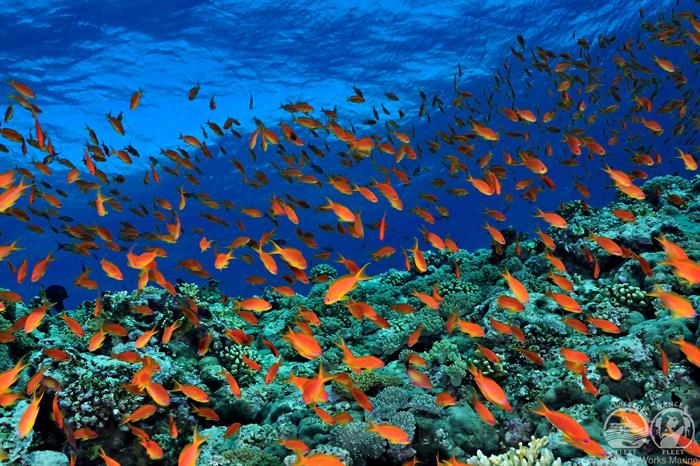The beauty of diving in Japan is in the options of location, dive sites, and type of diving.
Shiretoko Peninsula is the known spot for ice diving and the whole area is actually a UNESCO World Heritage Site. While this style of diving isn’t for everyone, it certainly appeals to some. Most ice dives take place in the Sea of Okhotsk or Lake Shikotsu. When diving off the peninsula in the Sea of Okhotsk, divers can experience 20 meters visibility and an incredible light display created by the sun penetrating the ice overhead. Keep your eyes peeled for Sea Angels – transparent sea slugs that dance in open water. Lake Shikotsu is known as the clearest and one of the deepest lakes in Japan. Divers can witness the spawning of red salmon if they dive during the salmon season. Expect to dive in dry suits to a depth of around 15 meters, in a water temperature of about 3 C.
Okinawa Island and the surrounding islets (mentioned below) are Japan’s best-known dive destinations. The Okinawa water temperature is considered subtropical, with a low of 21 C and a high of 31 C. Okinawa diving includes reefs, WWII wrecks, underwater caves, and brilliant marine life. The most spectacular marine life includes schooling hammerheads, manta rays, migrating whales and impressive schools of Jack fish.
How to get there: take a 2 ½ -hour direct flight from Tokyo.
Ishigaki Island is famous for its cleaning station which attracts a stunning number of manta rays. The highlight here is descending to only about 10 meters and watching these gentle giants swoop overhead.
How to get there: take a 1-hour flight from Okinawa.
Kerama Island boasts some of the Okinawa Prefecture’s most vibrant coral and spectacular macro life. Turtles are common here and migrating humpback whales can be spotted between January - March.
How to get there: high-speed boats run daily from Okinawa taking anywhere between 35 – 50 minutes.
Miyakojima Island is less about the coral and marine life and all about the amazing limestone rock formations. The sites around here are for the adventurous who wish to explore tunnels, swim-throughs, and underwater domes.
How to get there: a 50-minute flight from Okinawa is the only way to access this island.
Tokunoshima Island (100 kilometers north of Okinawa) is a coral reef haven. Drift dives are common here and it’s very likely you’ll spot the unique resident turtle (with a shell shaped like a mountain) on one of your dives.
How to get there: accessible by plane or ferry from Okinawa
Kozushima is surrounded by clear waters, abundant corals, and excellent macro life like sea slugs, nudibranch, starfish, and crabs. You might find octopus and sea snakes during a night dive.
How to get there: a two-hour or overnight ferry (5-7 hours) from Tokyo or a quick 30-minute flight.
Osezaki has depth, drop-offs, and hundreds of creatures like moray eels and sea bass to satisfy experienced divers. Its shallow boulders also make it an ideal training spot for learners or new divers. The random objects (like old tires and rope) scattered over the sandy bottom create a fun environment to practice search and recovery or navigation skills.
How to get there: drive south 150 kilometers from Tokyo.
Atami is a popular dive site close to Osezaki. Schooling hammerheads are the draw here – if the time is right!
Hachijojima isn’t the most convenient to reach, but this volcanic island and its black sandy shores beckon to divers who are looking for some variety. Diverse marine life including butterfly fish, angelfish, trumpetfish and a plethora of turtles and warm water are big attractions for Tokyo-based divers.
How to get there: take the 12-hour overnight ferry from Tokyo.








